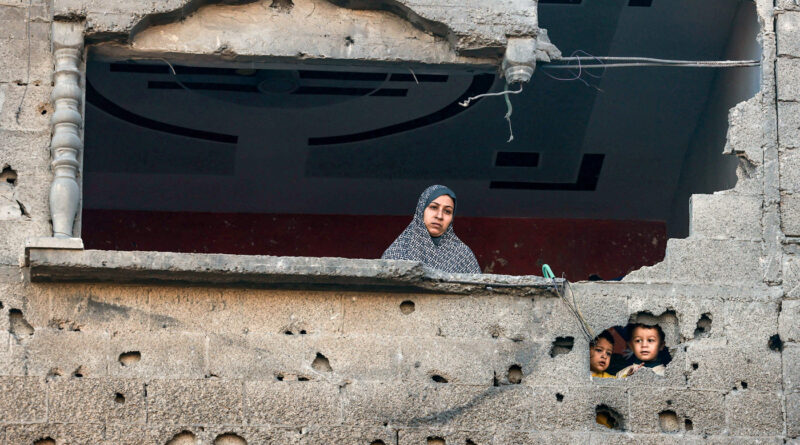This Is Why Gazan Women Are Wearing Hijab 24/7 – Muslim Girl
With nearly 37,000 deaths and 66,000 injuries within the tiny Gaza Strip, Palestinian women remain devoutly committed to their hijab despite the 117 days of continuous and brutal bombardment. Within the Western world, we take pleasure in perfecting our hijab — ironing and pinning it to our desired look. It is a means of expression, and we act as flag-bearers of our beloved faith.
The IOF knows no limits as they brutally murder and ethnically cleanse Palestinians in Gaza. Their respect for hijab is as non-existent as their respect for human life. Despite the increased difficulty to abide by proper hijab whilst fleeing drone attacks and snipers, Gazan women are choosing to remain covered in their hijabs and praying robes, so that they may spend their final moments as strong, veiled Muslim women.
About 98% of the Palestinian population is Muslim. As such, an important lifestyle and religious commitment is that of wearing a hijab and dressing modestly. Hijab is far more than covering our heads; it extends to our character and kindness too.
Videos and stories have been surfacing of women covered head-to-toe in what is called an “isdal,” or “chador” depending on the language and dialect. It is a form of dress used for prayer that covers the body with openings for the face and hands. Another variation exists in which the prayer dress comes in two pieces—a top and a skirt. The isdals or chadors exist in a variety of patterns, fabrics, and colors, and are often gifted to loved ones.
Gazan women have long been accustomed to living in their prayer dresses for extended periods of time. This is due to the absolute uncertainty in day-to-day life in Gaza, as a drone attack could happen at any moment. In the case that they must quickly escape their homes, they wear a prayer dress to sleep. Another instance that has compelled women to remain in hijab at all times is the possibility of death. If their buildings were to collapse, they wish to be veiled once found. In an Al Jazeera article, Palestinian Sarah Assaad shares that “if [they] were to die when [their] house is bombed, [they] want to have [their] dignity and modesty [… they] don’t want to be rescued wearing nothing.”
Palestinians simply do not know if they will live to see another day. There is no living beyond the current moment. Life is uncertain for them.
Gazan women have long been accustomed to living in their prayer dresses for extended periods of time. This is due to the absolute uncertainty in day-to-day life in Gaza, as a drone attack could happen at any moment.
Hijab also remains an important symbol of resilience as IOF soldiers continue to exploit and demoralize Palestinians. Following images arising December 6, 2023, IOF soldiers were shown stripping Gazan men to their underwear, with hands behind their heads defenseless. Often in war, unclothing and humiliating the victim is used to destabilize power hierarchies and impose power structures in which victims feel inferior to the perpetrator.
As such, the imminent danger caused by Israel to Palestinian people has led to veiled women forcibly removing their hijab. The IOF has forced women to prepare for death, and so Muslim Gazan women sleep in their hijabs to preserve their dignity and faith in their final moments. In another Al Jazeera article, a woman’s prayer clothes have been described as the “official uniform in an emergency situation” as its thin, baggy characteristics make it best to move swiftly and remain unexposed in case of catastrophe.
The prayer dress, though now associated with pain and genocide, once held pleasant connotations as well. The bright colors and beautiful designs were often worn during celebrations such as Eid. A mother often gifted her daughter one as she aged.
The admiration and respect for Gazan women devoted to their hijab in times of destruction and death is immense. We, as Muslim women in the West, experience bad hijab days when all we have done is walk outside and our hijab begins to slip off our heads. We sigh with relief as we come home at night and let our hair out of the tight bun. This week, Feb. 1, 2024 — World Hijab Day came upon us, and with this day comes appreciation and love for the hijab and all those who wear it.
Gazan women have spent months in their hijab while fleeing missiles, white phosphorus, Israeli tanks, and snipers, while also caring for their loved ones, providing medical aid, speaking to the media, and nurturing their children. Their hijab does not limit them even in times of crisis, but instead completes them. Gazan women are unwaveringly wearing their veils, with the understanding that their dignity extends beyond death.
Follow Muslim Girl on social media platforms to keep yourself updated on what is happening across the globe.




